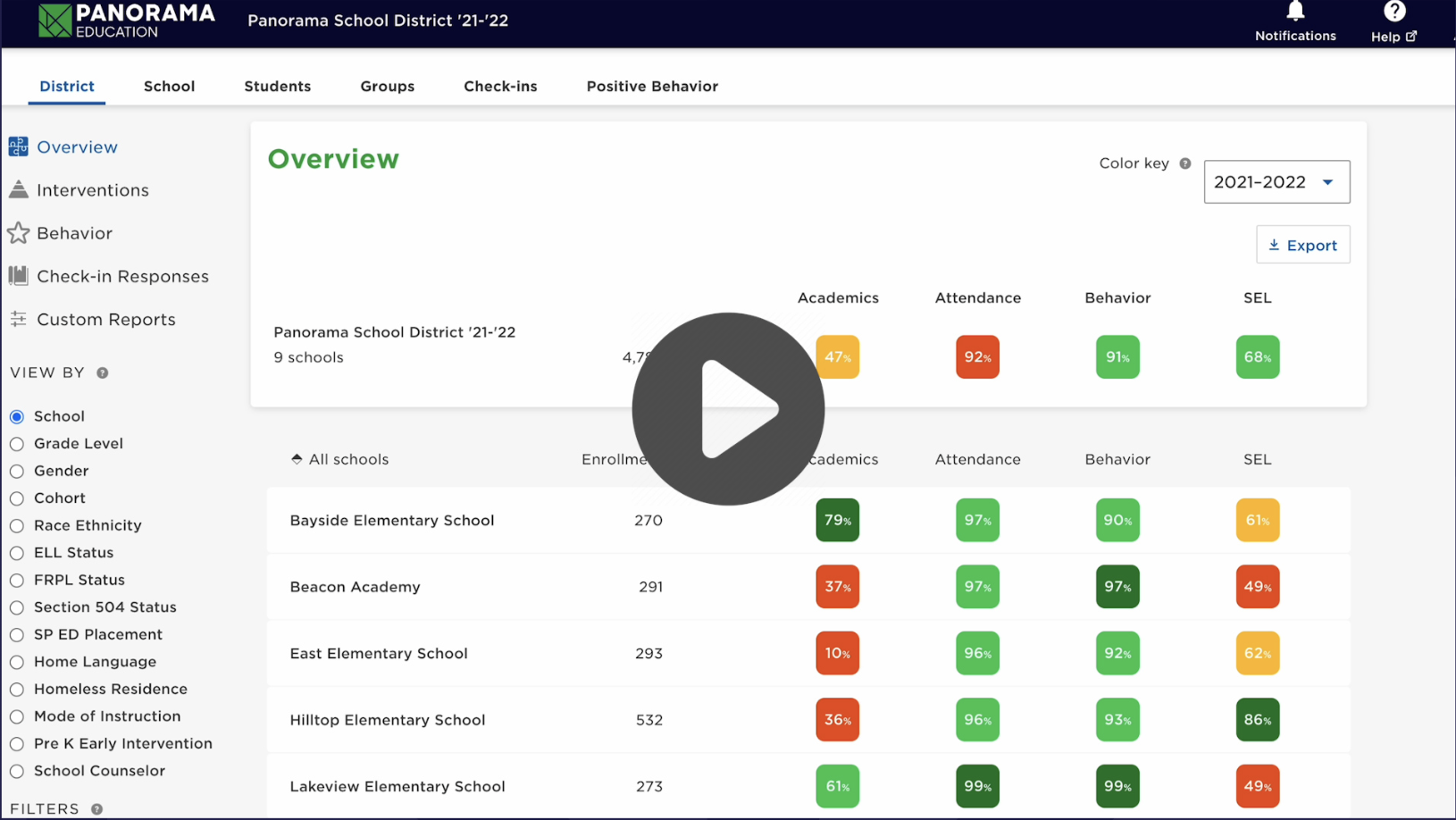School counselors support students across every area of their learning—providing help with academics, behavior, and life skills, as well as college and career readiness. This is why counselors are such a vital part of an MTSS and can be true leaders in their districts at every tier of support.
A former school counselor, Dr. Danielle Duarte is currently the Chief of Staff for Hatching Results, an educational organization that supports the development of data-driven school counseling programs that positively impact student outcomes. She is also the co-author of two books Hatching Results for Elementary School Counseling and Hatching Results for Secondary School Counseling.
At Panorama’s Thriving Schools Virtual Summit, Duarte shared about her time as a school counselor at Potter Jr. High School in Fallbrook, CA, where she was the only counselor serving 900 students. Duarte could see that her students needed more support and worked to rebuild the existing system to better serve her school. “In this role, I could have provided reactive services all the time,” said Duarte. “My office could have been a revolving door of just kids coming in with crises. But what I wanted to do was to design and implement a comprehensive school counseling program to do my very best to meet the needs of all 900 students.”
Duarte used Trish Hatch’s concept of a Multi-Tiered, Multi-Domain System of Supports (MTMDSS) to create her vision for a comprehensive counseling program for her school and district that would support students in academics, behavior, and college and career readiness across Tiers 1, 2, and 3.
Duarte’s work shows how instrumental school counselors can be as leaders within their districts’ MTSS practices. Here are 3 key takeaways from Dr. Duarte on how counselors can lead MTSS work in their districts.
Watch a 3-Minute Demo of Panorama for MTSS |
Key Takeaway #1: Collect and Share Data to Support Your Initiatives
“Data helps us drive our counseling program and better understand what our students need, and how we as a counseling team can work together to design a counseling curriculum across schools,” said Duarte. Her team conducted several student surveys throughout the year, asking students questions around relationships with teachers and peers and their experience and feelings at school. The responses from these surveys helped Duarte see areas of strength for the school as well as areas that might need further support from counselors, informing what practices she chose to implement.
Student voice data can not only help you shape your initiatives, but it also provides school and district leadership and board members with visibility into your work and its value to students. Additionally, data can be proof of your needs—this is particularly important when it comes to decision-making around things like hiring additional staff or purchasing tools or curriculum.
When getting started with data collection, Duarte advises that counselors start small. She suggests deciding on one or two areas to track, such as student-teacher relationships. Once you have a system that works for you, think about how you can continue to build and track multiple factors.
|
Panorama’s Surveys collect insightful feedback from students, families, and educators on a variety of topics including school climate and family engagement. Analyze your findings to help you make informed, data-based decisions to improve your district. All surveys run on Panorama are selected and customized by the local school or district that is administering the survey. View a sample student survey here. |
Key Takeaway #2: Solidify Tier 1 to Support All Students
Tier 1 interventions are established for all students and educators across all settings, providing a solid foundation. Examples of strong Tier 1 supports include high-quality core instruction, embedding life skills into curriculum and assessment, and cultivating a positive and inclusive school climate.
“Tier 1 is designed to be comprehensive, preventative, developmental, and proactive,” said Duarte. “There's a focus and there's a vision to my counseling program. We’ve been really thoughtful about the work we’re putting into it.” When Duarte first started her position in California, she compared the time she was spending on her counseling duties to the time recommendations for middle school counselors from the American School Counselors Association (ASCA).

Duarte’s comparison of ASCA recommendations vs. her actual time approximation (Source: Danielle Duarte)
The ASCA suggests counselors spend 25-35% of their time developing Tier 1 counseling curriculum. In actuality, Duarte was only spending 10% of her time on Tier 1 and 65% of her time responding to urgent student crises. Tier 1 interventions are a proactive measure, intended to support students before they get to a crisis point. But Duarte was spending so much time responding to crises that she wasn’t able to expand those crucial Tier 1 supports.
To create a Tier 1 foundation, Duarte worked with educators in her district to:
- Provide lessons, workshops, and activities for all students on topics concerning life skills, academics, and college and career readiness
- Advocate for expanding the mental health team to include more full-time counselors
- Ensure counselors have a visible presence on campus
- Choose school-wide programs and curricula for consistent support and expectations
- Align counseling initiatives with school and district goals
After implementing these supports, Duarte noted changes in both the elementary and middle school. Data in the elementary school showed reduced absences for students. At the middle school, they noticed fewer students receiving failing grades, and students reported an increased understanding of college and career requirements as they prepared for course selection in high school.
Key Takeaway #3: Determine How Your Counseling Practice Fits Into a Larger System
Many counselors work in a single school within a larger district. Every school is different and has its own culture and needs, but when we think of individual schools as a part of a whole, we can create a system of support from kindergarten all the way to high school graduation.
“One of the reasons why people get so confused about the role of school counselor is that it can look different from school to school. An administrator at one school might see counselors that are doing preventative classroom lessons, and then at another school they may be doing mostly Tiers 2 and 3,” said Duarte. “Really, we should be using the whole MTMDSS model consistently across the entire district.”
It can be difficult to implement these changes, especially if you have a small mental health team. This is why it’s so important to continue collecting and sharing data with classroom educators, administrators, district leaders, and board members. You can, however, help identify solutions that will help your district implement a strong MTSS. Counselors can:
- Vet tools and curricula that serve your community’s needs
- Build classroom educators’ capacity for teaching Tier 1 lessons
- Identify sources of funding (grants, etc.) that can pay for additional staffing needs
Above all, Duarte wants counselors to believe in themselves and their abilities to be leaders. “I do believe that all school counselors are leaders. No matter what your title is, you can be a leader in this work,” Duarte said. “And it's okay if things aren't perfect and you're just starting with a small part of your comprehensive model. Remember to give yourself grace and have patience.”


.jpeg)



.png)
